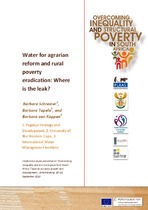| dc.description.abstract | The distribution of water use is undoubtedly the sharpest inequality inherited from the past in South Africa, with a Gini Coefficient of 0.96 and higher. Unfortunately, as the review in this paper suggests, the gap is even further widening for the large majority of black communities in informal rural and peri-urban areas. Neither government nor civil society has been very effective in tapping the potential of water storage and infrastructure development on a large enough scale to mitigate seasonal and annual variability and unpredictability of rainfall and, thus, to improve year-round productivity of agriculture-based livelihood strategies, such as cropping, horticulture, livestock, tree growing, brick making, crafts, and small-scale enterprises.
The paper’s analysis highlights that a champion department for storage and infrastructure development, which coordinates well with other departments, is lacking in post-1994 South Africa. The Department of Water Affairs has mainly been focusing on the regulation of existing and new large-scale water uses, among others through the new water entitlements regime of water use licenses. International experience has shown that formal license systems tend to ignore well-functioning informal arrangements, while privileging the administration-proficient. In spite of pertinent legal and policy statements about the re-allocation of water from the haves to the have-nots, the Water Allocation Reform (WAR) programme, led by the Department of Water Affairs since 2005, has had little impact. The legal option of priority General Authorizations for small-scale water uses, based on a quantification of the inequities, is proposed as an alternative or additional approach. The drastic withdrawal of pre-1994 support to smallholder irrigation schemes by the Department of Agriculture led to widespread partial or full collapse of irrigation schemes. The revitalization of these schemes appears highly problematic. Joint ventures tend to generate a small group of elite ‘arm-chair farmers’ at the expense of many more plot holders whose land is taken.
In the meantime, the scarce remaining water resources are rapidly taken up by the minority formal economy, which fiercely protects this expansion. Indeed, for most rural and peri-urban poor, their own informal initiative is the major way to obtain access to water for productive uses. In various pockets, such informal water development is vibrant. The paper concludes with the importance of recognizing and building on these informal arrangements. | en_US |

